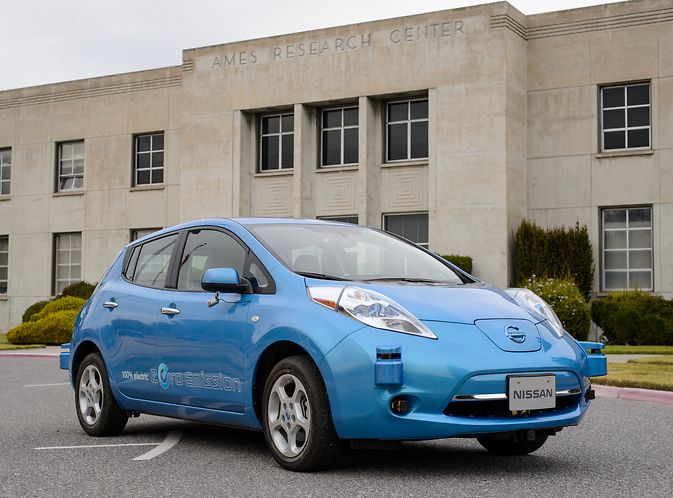Rs. 75 Crore Earmarked for Electric Vehicles

Finance Minister Arun Jaitley outside the Parliament before presenting the Union Budget.
Profit.ndtv.com: Finance Minister Arun Jaitley today earmarked Rs. 75 crore for faster adoption and manufacturing of electric vehicles in 2015-16, a step which electric vehicles makers termed as a good beginning.
"Government is also launching a scheme for faster adoption and manufacturing of electric vehicles (FAME) with an initial outlay of Rs. 75 crore," he said.
Further, the concessional excise duty of 6 per cent on specified goods for use in manufacture of electrically operated vehicles and hybrid vehicles, presently available up to this March, is being extended for another year.
Reacting to the development, Society of Manufacturers of Electric Vehicles (SMEV), Director-Corporate Affairs, Sohinder Gill termed the allocation towards promoting electric vehicles and supporting charging infrastructure and R&D investments as a welcome step.
"Its like a life saver for the ailing companies who had invested into the environmentally friendly vehicles but were bleeding heavily because of the lack of government support," he added.
In addition to supporting the industry National Electric Mobility Mission Plan (NEMMP) will create a significant positive impact on the health index of country by promoting zero pollution electric vehicles and reducing the dependence on the fossil fuel.
Elaborating further, he said that the biggest beneficiary of the (NEMMP) will be companies manufacturing electric two wheelers and small electric cars, who have managed to survive through the difficult years and have been still active in the market.
"Although we are awaiting details, it is expected that aroundRs. 1,000 cr will be allocated for a period of two years, a large part of which will go directly into the hands of the customers in term of reduction of the prices of electric vehicles by around 20 per cent and in installing charging stations in many cities," he added.
The government has an ambitious target of putting 5 million electric and hybrid vehicles per year on the road by 2020 under the NEMMP.
"A clear roadmap on GST, increased investment in infrastructure, agriculture investment and reforms, increased alloaction to electric vehicles and a focus on skilled development will also support auto demand," said PwC India, auto expert and partner, Abdul Majeed.
The previous UPA government had launched the NEMMP 2020 in 2013. The targets were envisaged to result in substantial lowering of vehicular emissions and decrease in carbon dioxide emissions by 1.3 per cent to 1.5 per cent in 2020 as compared to a status quo scenario.
It was estimated that the government would need to provide support to the tune of Rs. 13,000-14,000 crore over a period of 5-6 years to facilitate R&D and put in place charging infrastructure.

Finance Minister Arun Jaitley outside the Parliament before presenting the Union Budget.
Profit.ndtv.com: Finance Minister Arun Jaitley today earmarked Rs. 75 crore for faster adoption and manufacturing of electric vehicles in 2015-16, a step which electric vehicles makers termed as a good beginning.
"Government is also launching a scheme for faster adoption and manufacturing of electric vehicles (FAME) with an initial outlay of Rs. 75 crore," he said.
Further, the concessional excise duty of 6 per cent on specified goods for use in manufacture of electrically operated vehicles and hybrid vehicles, presently available up to this March, is being extended for another year.
Reacting to the development, Society of Manufacturers of Electric Vehicles (SMEV), Director-Corporate Affairs, Sohinder Gill termed the allocation towards promoting electric vehicles and supporting charging infrastructure and R&D investments as a welcome step.
"Its like a life saver for the ailing companies who had invested into the environmentally friendly vehicles but were bleeding heavily because of the lack of government support," he added.
In addition to supporting the industry National Electric Mobility Mission Plan (NEMMP) will create a significant positive impact on the health index of country by promoting zero pollution electric vehicles and reducing the dependence on the fossil fuel.
Elaborating further, he said that the biggest beneficiary of the (NEMMP) will be companies manufacturing electric two wheelers and small electric cars, who have managed to survive through the difficult years and have been still active in the market.
"Although we are awaiting details, it is expected that aroundRs. 1,000 cr will be allocated for a period of two years, a large part of which will go directly into the hands of the customers in term of reduction of the prices of electric vehicles by around 20 per cent and in installing charging stations in many cities," he added.
The government has an ambitious target of putting 5 million electric and hybrid vehicles per year on the road by 2020 under the NEMMP.
"A clear roadmap on GST, increased investment in infrastructure, agriculture investment and reforms, increased alloaction to electric vehicles and a focus on skilled development will also support auto demand," said PwC India, auto expert and partner, Abdul Majeed.
The previous UPA government had launched the NEMMP 2020 in 2013. The targets were envisaged to result in substantial lowering of vehicular emissions and decrease in carbon dioxide emissions by 1.3 per cent to 1.5 per cent in 2020 as compared to a status quo scenario.
It was estimated that the government would need to provide support to the tune of Rs. 13,000-14,000 crore over a period of 5-6 years to facilitate R&D and put in place charging infrastructure.

 Photo: NASA/Ames/Dominic HartAn all-electric Nissan Leaf equipped with autonomous drive systems parked at NASA’s Ames Research Center in Silicon Valley.
Photo: NASA/Ames/Dominic HartAn all-electric Nissan Leaf equipped with autonomous drive systems parked at NASA’s Ames Research Center in Silicon Valley.















 Our Porsche 717 artist's impression (by Andreas Hartl)
Our Porsche 717 artist's impression (by Andreas Hartl)





 Stephen King is a professor of economics at Monash University.
Stephen King is a professor of economics at Monash University.
 , but this breakdown has more models and a niftycolorchart.
, but this breakdown has more models and a niftycolorchart.